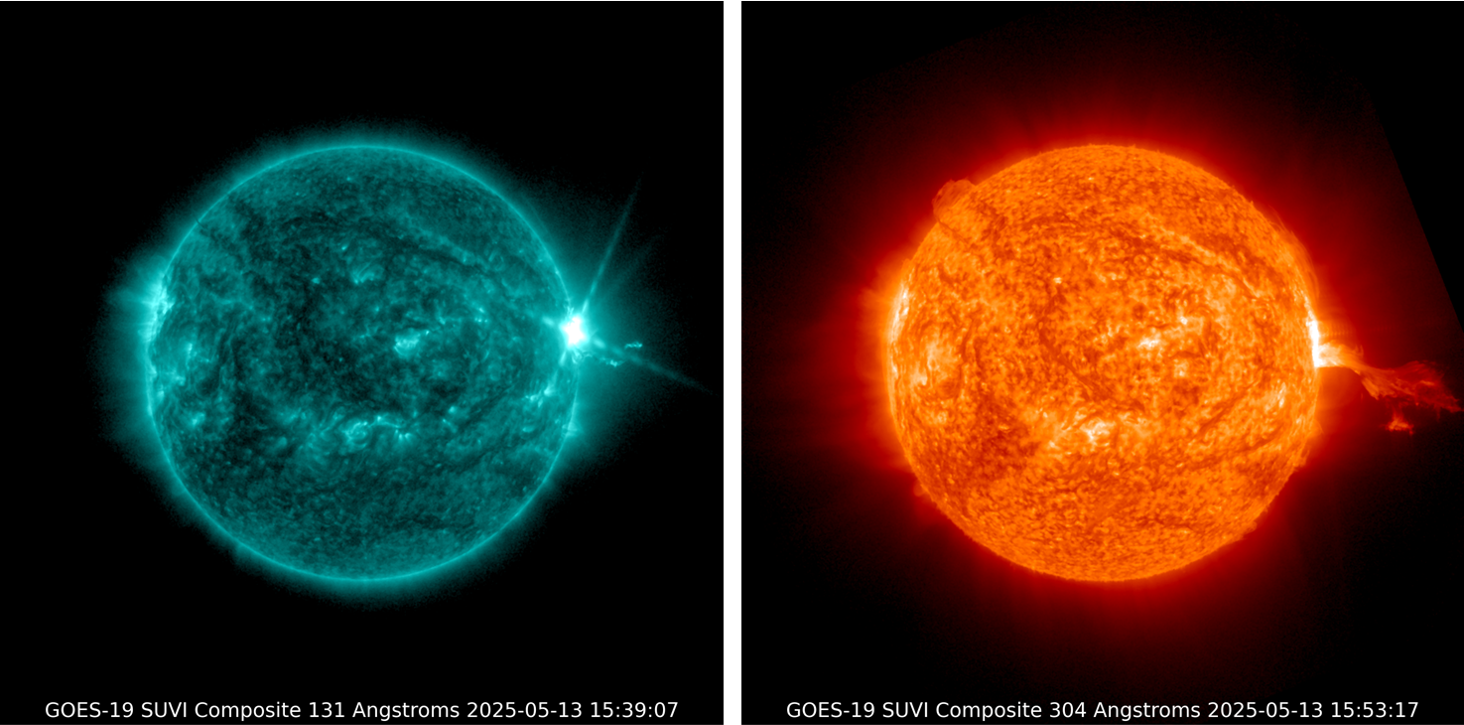After the departure of the large but relatively quiet sunspot group NOAA 4079, the earth-facing solar hemisphere was left with only a few and small sunspot groups. From such a small region, an X1.2 flare originated today 13 May at 15:38UTC (GOES; graph). The source of this X1.2 flare -the "X" meaning eXtreme- was NOAA 4086. It is still located close to the northwest solar limb making an accurate analysis of its magnetic configuration difficult. At any rate, from its size and the white light outlook (SDO/HMI image), it would have been a longshot to predict an X-class flare. The GOES/SUVI images underneath show the eruption in extreme ultraviolet (EUV) near temperatures of several million degrees (left; SUVI 131) and near 80.000 degrees (right; SUVI 304). The diffraction patterns that can be seen in this image are instrumental (more information is in Note 1 of this STCE newsitem). The SUVI 304 image clearly shows that material is ejected into interplanetary space.

The radioastronomy station in Humain (Belgium) clearly shows a Type II radio burst, supporting the EUV imagery that a coronal mass ejection (CME) was most likely associated with the eruption. This can be seen in the radio spectrogram underneath (Horizontal axis: time; vertical axis: frequency, with lowest values on top), with a Type III (the "vertical" lines) around 15:35UTC and the Type II (upward moving "patch") lasting until about 15:53UTC. Because of the location of the source region, the bulk of the associated CME is not directed to Earth, however a glancing blow can not be excluded at this time. Standing-by coronagraphic imagery and the analysis by the SIDC space weather forecaster.

In view of the source location (western solar hemisphere) and the intensity of the solar flare, it is no surprize that the greater than 10 MeV proton flux started to increase from 16:15UTC onwards. The proton flux is currently (around 18:00UTC) near 4 proton flux units (pfu), and there's a chance it may exceed the alert threshold of 10 pfu during the coming hours (GOES; chart). The greater than 100 MeV and 500 MeV proton fluxes have basically stayed at background levels, so there's for the moment no increase expected in the background radiation at the Earth's surface. NOAA 4086 is now rotating off the solar disk and will be beyond the solar limb from late on 14 May onwards. This source of today's X-class flare may then still leave a flaring signature in soft x-rays for another day, and -pending its activity- drive also the proton flux back upwards over the next few days.
The X-class flare affected the lower frequency portion of the High Frequency communication band (HF Com ; 3-30 MHz) mainly over the Atlantic Ocean, North- and South America, and the western portion of Africa. An advisory to civil aviation has been issued (PECASUS/CRC). The enhanced proton flux is currently also affecting the lower portion of the HF Com band, but in this case over the Arctic. In view of the low proton fluxes currently observed, the impact is still mild (for the moment).The effects of the flare and the proton flux enhancement on HF Com can be seen in the two D-RAP maps underneath (NOAA/SWPC).






